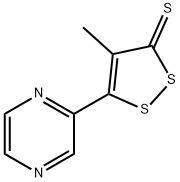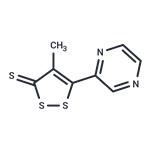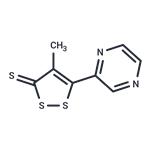Description
Oltipraz (64224-21-1) upregulates the transcription factor NRF2 and prevents insulin resistance and obesity induced by high fat diet in C57BL/6J mice.1 Attenuates the progression of fibrosis in a rat model of nonalcoholic steatohepatitis.2 Oltipaz attenuates chronic hypoxia-induced cardiopulmonary alterations in mice.3 Promotes liver regeneration after partial hepatectomy.4 Off target effects: Activates constitutive androstane receptor (CAR).5
Chemical Properties
Dark Red Solid
Uses
schistosomicide, antineoplastic
Uses
Oltipraz is a synthetic, substituted 1,2-dithiole-3-thione previously used in humans as an antischistosomal agent. Animal studies have demonstrated that oltipraz is a potent inducer of Phase II detoxification enzymes, most notably glutathione-S-transferase (GST). Oltipraz is now known to be used for tumor prevention purposes.
Definition
ChEBI: A 1,2-dithiole that is 3H-1,2-dithiole-3-thione substituted at positions 4 and 5 by methyl and pyrazin-2-yl groups respectively.
General Description
Oltipraz, a dithiol derivative, is a member of dithiolethiones class of organosulfur compounds. It has anti-tumor, antioxidative, anti- inflammatory and radioprotective properties. It provides protection from numerous carcinogens. Oltipraz functions as a schistosomicide.
Biochem/physiol Actions
Oltipraz is an activator of Nrf2. Nrf2 (NF-E2-related factor 2) is a transcription factor that binds to antioxidant response elements (AREs) and activates these genes. Oltipraz activates Nrf2 and subsequently elevates expression of the detoxification genes encoding anti-oxidant and multidrug resistance-associated proteins to mediate its chemopreventive efficacy.
References
1) Yu?et al. (2011),?Oltipraz upregulates the nuclear factor (erythroid-derived 2)-like 2 (NRF2) antioxidant system and prevents insulin resistance and obesity induced by a high-fat diet in C57BL/6J mice; Diabetologia,?54?922
2) Shimozono?et al. (2013),?Nrf2 activators attenuate the progression of nonalcoholic steatohepatitis-related fibrosis in a dietary rat model; Mol. Pharmacol,?84?62
3) Eba?et al. (2013),?The nuclear factor erythroid 2-related factor 2 activator oltipraz attenuates chronic hypoxia-induced cardiopulmonary alterations in mice; Am. J. Respir. Cell. Mol. Biol.,?49?324
4) Cho?et al. (2009), Oltipraz promotion of liver regeneration after partial hepatectomy: the role of PI3-kinase dependent C/EBPbeta and cyclin E regulation; Arch. Pharm. Res.,?32?625
5) Merrell?et al. (2008),?The Nrf2 activator oltipraz also activates the constitutive androstane receptor; Drug Metab. Dispos.,?36?1716




